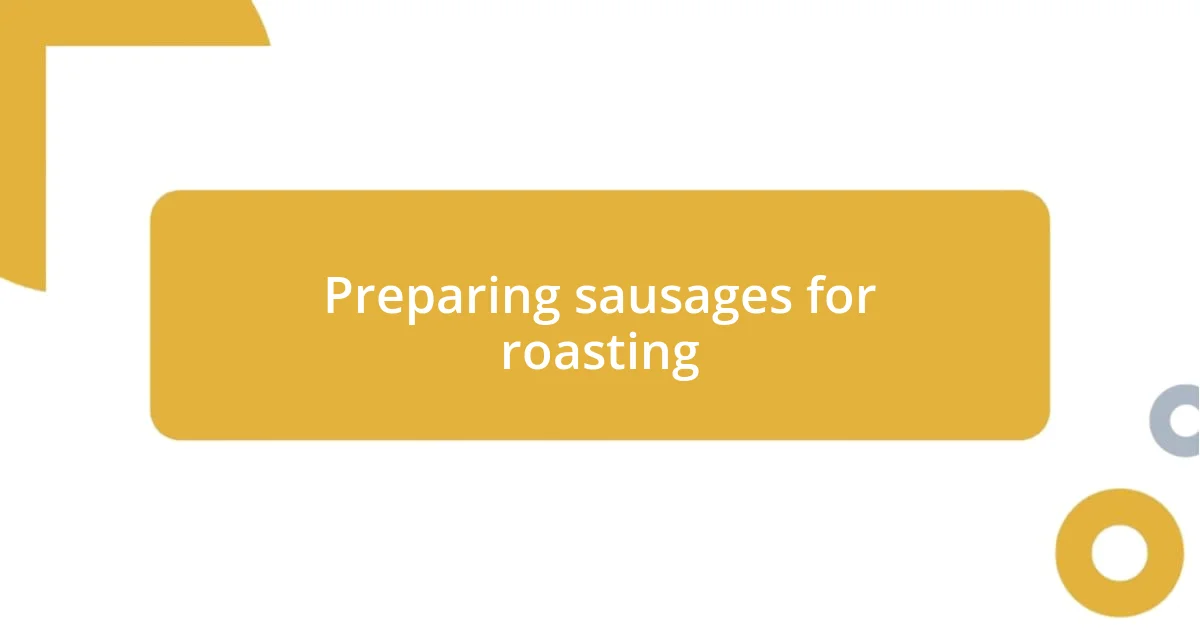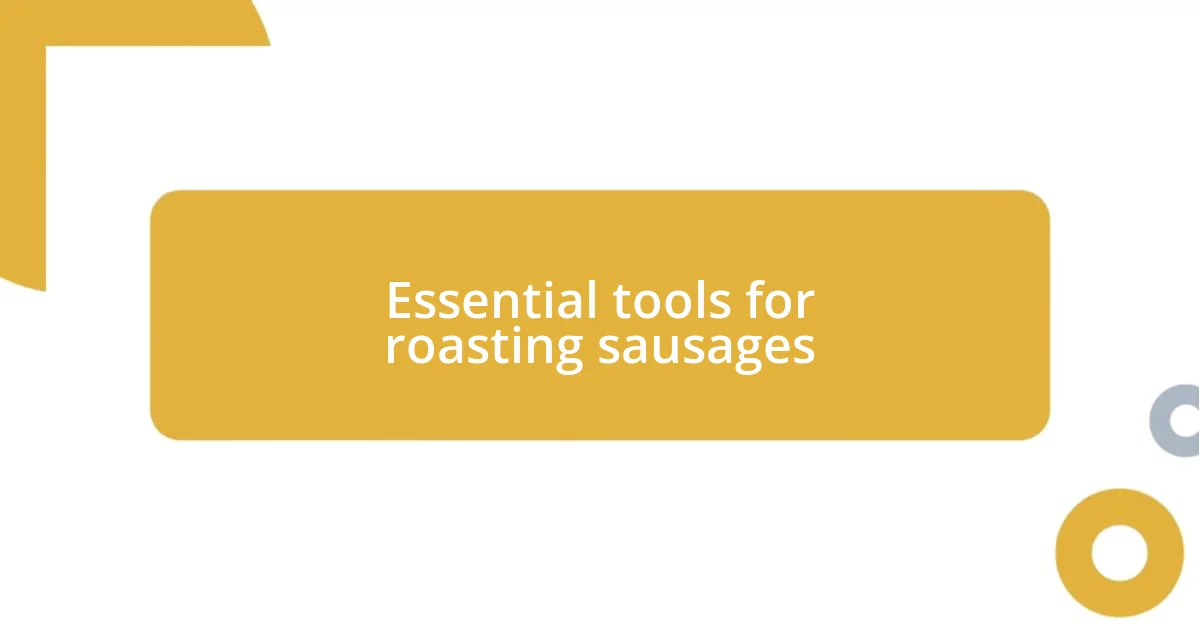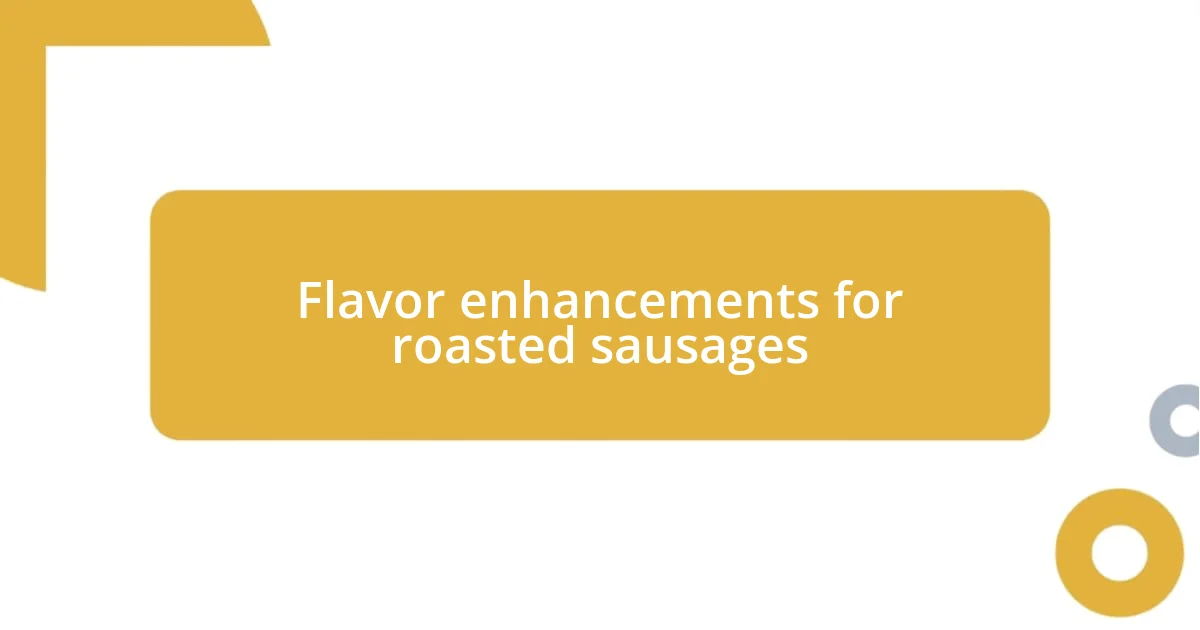Key takeaways:
- Select high-quality sausages and allow them to come to room temperature for even roasting.
- Use essential tools like a cast iron skillet and meat thermometer to achieve the perfect texture and ensure safety.
- Enhance flavors with marinades, herbs, and pairing with vegetables, while addressing common issues like uneven cooking and excess grease.

Preparing sausages for roasting
When preparing sausages for roasting, I always start by selecting high-quality links. I remember a time when I rushed this process, choosing whatever was on sale, and the result was a bland disappointment. Isn’t it amazing how the flavor can truly elevate the dish?
Next, I like to allow the sausages to come to room temperature before cooking. This little step makes a noticeable difference in how evenly they roast. Have you ever bitten into a sausage that was perfectly browned on the outside but still cold inside? It’s a letdown. Simply leaving them out for about 20 minutes does wonders for the texture and juiciness.
I also make it a habit to prick the sausages lightly with a fork to prevent them from bursting while they roast. This might seem counterintuitive, but trust me, it saves you from a messy kitchen! There’s nothing worse than having those lovely juices leak out and create a splatter than needlessly complicates clean-up. Plus, those tasty drippings can enhance your dish if they stay put!

Choosing the right sausage type
Choosing the right sausage type is just as crucial as the roasting technique itself. Different types offer distinct flavors and textures, which can significantly affect your final dish. I remember spending a weekend experimenting with various sausage types—Italian, bratwurst, and even a spicy chorizo. Each one brought something unique to the table, and it was a delightful journey to discover which one I loved most with roasted veggies.
When it comes to flavor profiles, I often find that my taste preferences lean towards robust sausages. For instance, a smoked sausage can complement a fall-themed roast beautifully, while a fresh, herb-infused sausage brings a lighter, fresher essence. It’s interesting how the right choice can transform a simple meal into a memorable experience. Have you ever tried contrasting spicy and sweet flavors? Just the other night, I paired a sweet apple sausage with some spicy peppers, and it was a total game-changer!
For those just starting on this flavor quest, here’s a quick comparison of common sausage types to guide your selection:
| Sausage Type | Flavor Profile |
|---|---|
| Italian | Herbal and savory, often with fennel or garlic. |
| Bratwurst | Rich and mildly seasoned, perfect with mustard. |
| Chorizo | Spicy and smoky, packed with paprika. |
| Apple sausage | Sweet and fruity, great for autumn dishes. |

Essential tools for roasting sausages
When it comes to roasting sausages, having the right tools makes all the difference in achieving that perfect crispy exterior and juicy interior. I’ve learned from experience that using a cast iron skillet is my go-to. The heat retention is fantastic, and I remember one evening when I was hosting a small dinner party. I roasted the sausages in that skillet, and the even browning was spectacular—my friends couldn’t stop raving about them!
Here’s a quick list of essential tools that help elevate your roasting game:
- Cast Iron Skillet: Retains heat well, providing even cooking and a great sear.
- Tongs: Perfect for flipping sausages without losing juices.
- Baking Sheet: If you prefer oven roasting, a sturdy, rimmed baking sheet works wonders.
- Meat Thermometer: Ensures sausages reach the ideal internal temperature for safety and flavor.
- Parchment Paper: Lining your baking sheet can simplify clean-up and prevent sticking.
As I continue to refine my sausage roasting techniques, I sometimes find that an unexpected tool adds a lovely twist. For instance, using a reliable roasting rack can help lift the sausages and allow heat to circulate evenly all around. The first time I tried this was during a cozy Sunday afternoon, and I was amazed at how crisp the bottoms turned out. I felt a sense of accomplishment that made the meal taste even better. It’s these little discoveries and the right tools that elevate the experience of roasting sausages, turning it into something truly special.

Best roasting techniques explained
To roast sausages perfectly, I’ve found that temperature matters significantly. Preheating my oven to around 400°F (204°C) ensures a golden, crispy outside while keeping the inside tender and juicy. I distinctly remember a roasting mishap when I got too eager and cranked it up too high—let’s just say the sausages turned out more charred than charming. Have you ever rushed the process and regretted it?
Another technique I love involves the art of sautéing first. By giving the sausages a quick brown in a skillet before transferring them to the oven, I can lock in those delightful juices. There’s something satisfying about watching them sizzle and brown, creating a mouthwatering aroma that fills the kitchen. Last Thanksgiving, I did just that, and the guests were drawn like moths to the flame—everyone wanted to know my secret!
Lastly, don’t underestimate the power of basting. A simple brush of olive oil or a splash of broth halfway through roasting can add another layer of flavor and moisture. I recall a summer evening when I roasted some chicken sausage with a bit of apple cider. The combination infused the meat with a hint of sweetness, making it a hit at the barbecue. Isn’t it fascinating how little techniques can elevate your sausage experience to new heights?

Ideal roasting temperatures and times
For roasting sausages, I’ve found that the ideal temperature ranges from 375°F to 425°F (190°C to 220°C). Personally, I prefer landing right in the middle at 400°F (204°C). It strikes the perfect balance between ensuring the sausages cook through without drying out. I recall a memorable weekend when I experimented within a wider range, learning firsthand how too low of a temp left me with sad, undercooked sausages, while anything much higher just resulted in a crispy exterior with a raw center. It’s a fine line to walk, but finding that sweet spot is rewarding.
Timing is equally crucial. Generally, sausages take about 25 to 30 minutes to roast fully, but I always check their internal temperature with a meat thermometer. I remember hosting a brunch where I aimed for that perfect 160°F (71°C) internal temperature for my pork sausages. The thrill I felt when I finally reached it was palpable; it’s reassuring to know you’re serving perfectly cooked meat! Have you ever waited nervously for that tiny beep to confirm your culinary success?
Also, it’s worth noting that flipping the sausages halfway through roasting can enhance their texture. I’ve come to view this as a ritual of sorts—imagine my kitchen filled with the aroma of sizzling sausages, and as I flip them, I can’t help but feel a surge of anticipation. Just thinking about that moment brings back childhood memories of family gatherings where the sausages would be the star of the show, perfectly browned and calling everyone to the table. Who doesn’t love that moment when a meal transcends mere nourishment and transforms into a cherished memory?

Flavor enhancements for roasted sausages
To elevate the flavor of roasted sausages, I often turn to herbs and spices. A sprinkle of crushed red pepper, a dash of garlic powder, or even fresh rosemary can transform the flavor profile dramatically. Last fall, while experimenting with fennel pollen, I discovered how it added a unique, aromatic depth to my roasted Italian sausages. It made me wonder—how often do we overlook simple seasonings that could elevate our dishes?
Marinades are another incredible way to infuse flavor. I typically marinate my sausages overnight in a mixture of olive oil, Dijon mustard, and a splash of balsamic vinegar. This not only enhances the taste but also ensures a beautiful crust forms during roasting. One particularly memorable cookout, I prepared some bratwursts this way, and the tangy flavor had my friends coming back for seconds—who doesn’t love a dish that sparks such enthusiasm?
Don’t forget about the power of pairing! Roasting sausages with vegetables like bell peppers and onions can enhance the overall meal with sweet, caramelized flavors. I’ll never forget the time I threw some chopped potatoes alongside my sausages, and the lovely perfume that wafted through my kitchen was pure magic. It’s incredible how a simple side can complement the main dish—what are your go-to sides that take the flavor to the next level?

Troubleshooting common roasting issues
When roasting sausages, one common problem I’ve encountered is uneven cooking. I once had a batch where some were perfectly golden while others were shockingly raw. The key? Even spacing on the roasting tray prevents crowding and allows heat to circulate. Have you ever felt that tense moment of slicing into a sausage only to find it pink inside? Flipping them often is beneficial, too—it feels like giving each sausage its fair shot at basking in the heat!
Another issue that can arise is excessive grease, which can lead to soggy sausages rather than that desired crispiness. I remember a time when I neglected to drain some of the accumulated fat, thinking a little extra flavor wouldn’t hurt. Much to my dismay, the result was grease spilling out all over my plate—a culinary disaster. To avoid this, I recommend placing sausages on a wire rack set over a baking sheet. This way, any drippings fall away, and the sausages can roast beautifully.
Lastly, underestimating cook times can leave you in a pickle. I vividly recall a dinner party when I miscalculated and served some sausages that weren’t quite done. I was mortified! Now, I always set a timer and have a reliable meat thermometer on hand. Just think—how wonderful it feels to share perfectly cooked sausages with friends, knowing the hesitation of undercooked meat is a worry of the past. It’s those moments that solidify the joy of cooking.















